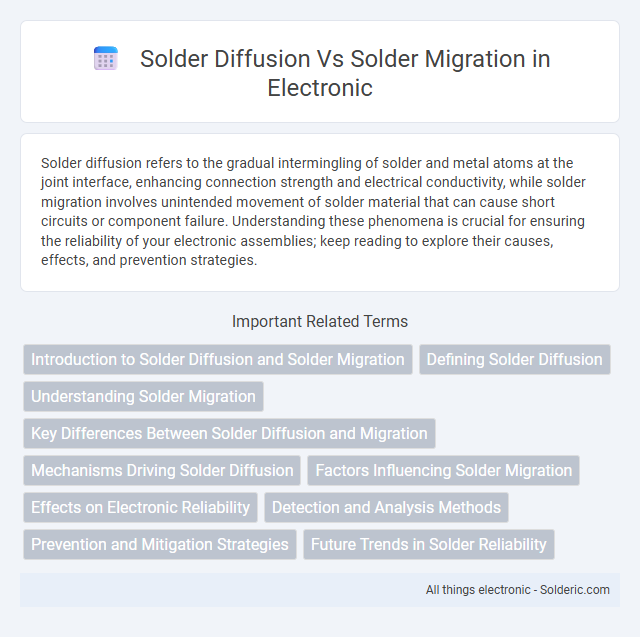Solder diffusion refers to the gradual intermingling of solder and metal atoms at the joint interface, enhancing connection strength and electrical conductivity, while solder migration involves unintended movement of solder material that can cause short circuits or component failure. Understanding these phenomena is crucial for ensuring the reliability of your electronic assemblies; keep reading to explore their causes, effects, and prevention strategies.
Comparison Table
| Aspect | Solder Diffusion | Solder Migration |
|---|---|---|
| Definition | Intermixing of solder and substrate atoms forming intermetallic compounds. | Unintended movement of solder material along circuit surfaces under electric fields. |
| Mechanism | Atomic diffusion driven by concentration gradients and heat. | Electromigration caused by current flow and electric field forces. |
| Conditions | High temperature during soldering process. | DC current presence on a circuit board over time. |
| Impact | Formation of brittle intermetallic layers affecting joint reliability. | Short circuits, open circuits, and device failure risks. |
| Control Methods | Optimizing soldering temperature and time, using flux. | Limiting current density, design layout improvements, protective coatings. |
| Common Applications | PCB assembly, microelectronic packaging. | High current circuits, LED modules, power electronics. |
| Detection Techniques | Metallurgical analysis, SEM imaging. | Electrical tests, X-ray imaging, visual inspection. |
Introduction to Solder Diffusion and Solder Migration
Solder diffusion refers to the intermingling of atoms between solder and substrate materials during soldering, resulting in metallurgical bonding crucial for joint strength and reliability. Solder migration is the undesirable movement of solder away from the intended joint location, often caused by electrical bias, moisture, or contamination, leading to circuit failures and reliability issues. Understanding these phenomena is essential for optimizing solder joint integrity in electronic packaging and assembly processes.
Defining Solder Diffusion
Solder diffusion is the process where solder atoms gradually intermix with base metal atoms at the interface, resulting in metallurgical bonding that enhances joint strength. This phenomenon occurs during soldering when heat causes atomic movement across the interface, forming intermetallic compounds. Unlike solder migration, which involves the physical movement of solder material, diffusion is characterized by atomic-level blending crucial for reliable electronic connections.
Understanding Solder Migration
Solder migration refers to the unintended movement of solder material across a circuit board, often driven by electric fields and environmental factors, which can cause short circuits and reliability issues. Understanding solder migration is crucial for improving the durability and performance of electronic assemblies by preventing these defects. Your designs benefit from controlling this phenomenon through proper material selection, layout strategies, and environmental controls to mitigate solder diffusion-related failures.
Key Differences Between Solder Diffusion and Migration
Solder diffusion involves the gradual intermixing of solder and base metal atoms at the joint interface, enhancing bond strength and reliability through solid-state atomic movement. In contrast, solder migration refers to the unintended movement of solder material across circuit surfaces, often causing short circuits and device failure due to electrochemical or thermal stress. Understanding these key differences helps you manage soldering processes effectively to ensure optimal electronic component performance and longevity.
Mechanisms Driving Solder Diffusion
Solder diffusion occurs when atoms from the solder alloy move into adjacent materials, driven primarily by concentration gradients and temperature-induced atomic mobility. This process is facilitated by mechanisms such as grain boundary diffusion, volume diffusion, and surface diffusion, which collectively accelerate atomic movement within the solder joint. Understanding these diffusion pathways helps you predict solder joint reliability and prevent premature failure in electronic assemblies.
Factors Influencing Solder Migration
Solder migration is primarily influenced by factors such as high humidity, elevated temperatures, and the presence of electric fields, which accelerate ionic movement on circuit boards. Contaminants like flux residues and ionic impurities significantly enhance solder migration by lowering surface resistivity and promoting dendritic growth. Additionally, the choice of substrate material and the quality of surface finishes impact the extent and rate of solder migration in electronic assemblies.
Effects on Electronic Reliability
Solder diffusion involves the gradual intermixing of solder and base metals, leading to the formation of intermetallic compounds that enhance joint strength but may cause brittleness over time, impacting electronic reliability. Solder migration, however, refers to the movement of solder away from its original location, often driven by temperature gradients or electric fields, which can create open circuits and failure points. Understanding these phenomena helps you mitigate risks and ensure long-lasting, reliable electronic assemblies.
Detection and Analysis Methods
Solder diffusion is typically detected through metallographic cross-section analysis and energy-dispersive X-ray spectroscopy (EDS) to examine elemental intermixing at solder interfaces. Solder migration is analyzed using microscopy techniques such as scanning electron microscopy (SEM) combined with surface analysis tools to identify mass transport paths and corrosion byproducts. Your choice of detection method depends on whether you need to study atomic-level diffusion phenomena or macro-scale migration patterns affecting solder joint reliability.
Prevention and Mitigation Strategies
Solder diffusion can be prevented by using barrier layers such as nickel or gold plating between solder and substrate materials, which inhibit intermetallic compound formation. Solder migration mitigation involves controlling environmental factors like temperature, humidity, and ionic contamination, along with conformal coatings to minimize moisture-induced ion movement. Regular inspection and applying flux with proper viscosity also play key roles in reducing the risks associated with both solder diffusion and migration.
Future Trends in Solder Reliability
Future trends in solder reliability emphasize advanced materials and microstructural engineering to control solder diffusion, preventing premature joint degradation caused by atomic intermixing. Research in solder migration focuses on mitigating ionic movement under electrical and thermal stress, which can induce dendritic growth and short circuits in high-density electronic assemblies. Your devices will benefit from innovations like nano-alloyed solders and real-time monitoring techniques that enhance long-term performance and durability.
solder diffusion vs solder migration Infographic

 solderic.com
solderic.com